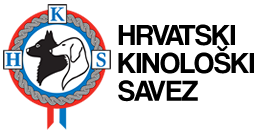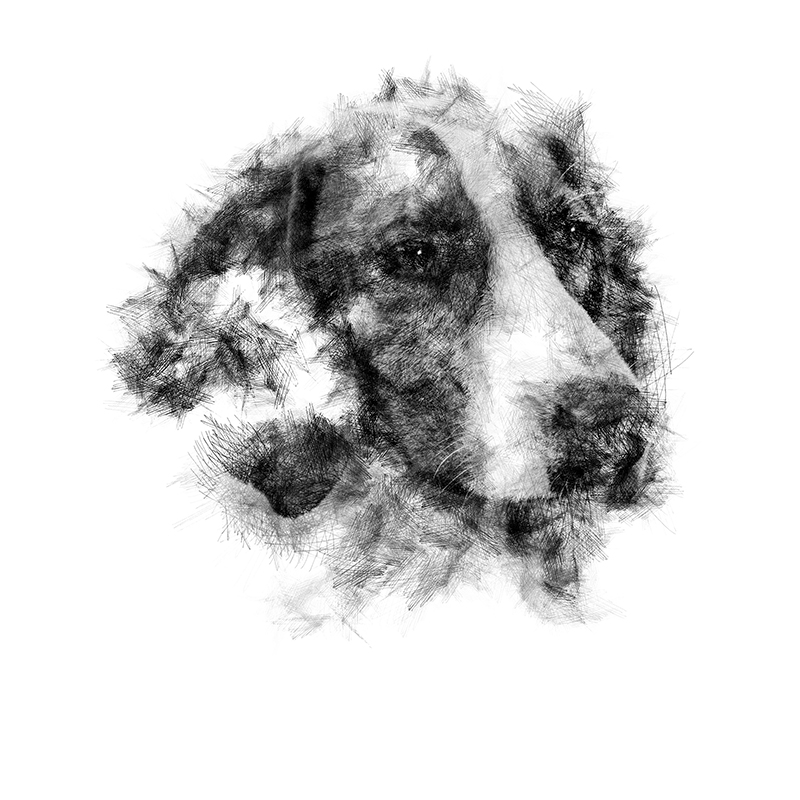FCI-Standard
N° 154 / 29 /05 / 2015 /
POSAVATZ HOUND
Posavski Gonič
FCI Group 6
Scenthounds and related breeds
Section1.2 / Medium sized scenthounds
-with working trial
The breed is easy to train. This is a universal hound with a clear and melodic voice for hunting in all areas. Docile, neither nervous nor aggressive, reasonably lively temperament. Very devoted to the owner.
Strong hound-body, medium sized dog with balanced movements.
The characteristic red-wheaten colour comes in all shades.
The white markings are on head, neck, on the fore chest, the chest, the belly, the lower limbs and at the tip of the tail.
The difference between the genders has to be distinctive.
Posavatz, the scent hound from the Save Valley is an old hound breed, which descents from a type of the “Illyrischen Hound of Red Colour with markings”. In the cemetery chapel next to the village of Beram (Istrien) one can find in the fresco, dating from 1474, “The bow of the three Kings” a dark wheaten dog with dropped ears. This was the first portrayal of the Posavatz Hound. The next portrayal is the altar fresco “The motherhood of the Holy Virgin Mary” from the 16th century in the Mother of the Angels Church in Veli Losinj, where the ancestor of today’s Posavatz Hound is depicted. There is also a description of this hound in a manuscript from the year 1719 of the Dakovear Bishop Petar Bakic, where it says, that the breeding of these hounds was already well known in the 14th century. Franjo Bertic describes the Posavatz Hound in the year 1854. The FCI published the first Standard for the Posavatz Hound on April 8th 1955.
TRANSLATION:
Christina Bailey / Official language (DE).
Revised by Renée Sporre-Willes.
ORIGIN:
Croatia.
DATE OF PUBLICATION OF THE OFFICIAL VALID STANDARD:
03.11.2014.
UTILIZATION:
A hound with excellent stamina especially suited to hunting hare, fox and boar but can also be used as a tracking leash hound.
BRIEF HISTORICAL SUMMARY:
Posavatz, the scent hound from the Save Valley is an old hound breed, which descents from a type of the “Illyrischen Hound of Red Colour with markings”.
In the cemetery chapel next to the village of Beram (Istrien) one can find in the fresco, dating from 1474, “The bow of the three Kings” a dark wheaten dog with dropped ears.
This was the first portrayal of the Posavatz Hound.
The next portrayal is the altar fresco “The motherhood of the Holy Virgin Mary” from the 16th century in the Mother of the Angels Church in Veli Losinj, where the ancestor of today’s Posavatz Hound is depicted.
There is also a description of this hound in a manuscript from the year 1719 of the Dakovear Bishop Petar Bakic, where it says, that the breeding of these hounds was already well known in the 14th century.
Franjo Bertic describes the Posavatz Hound in the year 1854.
The FCI published the first Standard for the Posavatz Hound on April 8th 1955.
GENERAL APPEARANCE:
Strong hound-body, medium sized dog with balanced movements.
The characteristic red-wheaten colour comes in all shades.
The white markings are on head, neck, on the fore chest, the chest, the belly, the lower limbs and at the tip of the tail.
The difference between the genders has to be distinctive.
IMPORTANT PROPORTIONS:
Rectangular body; length to exceed height at the withers.
Height to the elbow is 50% of the height at the withers.
The length of skull to slightly exceed the length of muzzle.
BEHAVIOUR / TEMPERAMENT:
The breed is easy to train.
This is a universal hound with a clear and melodic voice for hunting in all areas.
Docile, neither nervous nor aggressive, reasonably lively temperament.
Very devoted to the owner.
HEAD:
The head is well proportioned to the body.
The head has slight divergent lines.
CRANIAL REGION:
Skull:
Slightly longer than the muzzle, it is broadest between the ears.
The temporal area is slightly rounded.
The width of the skull exceeds its depth.
The occipital bone and the frontal furrow are slightly pronounced.
Stop:
Well developed but not too exaggerated.
FACIAL REGION:
Nose:
Strong with well-opened nostrils.
The whole nose and the inside of the nostrils have to be black or dark brown pigmented.
Muzzle:
Strong, rectangular and full, slightly shorter than the skull, tapering from the stop towards the nose but not too pointed.
The nasal bridge is straight or slightly convex (slight ram’s nose).
Lips:
Average thickness, tight-fitting to the jaw, the labial commissure is not visible.
The liprims are completely pigmented in correspondence with the colour of the nose leather.
Jaws/Teeth:
The jaws are strong, regular and the teeth are white and evenly placed in the jaws.
Scissors bite; the incisors are vertical placed in the jaws.
A complete bite is desired (42 teeth in accordance with the dental formula).
Missing premolars PM1 and molars M3 are not taken into account.
The missing of other teeth is undesirable.
Cheeks:
The chewing muscle and the cheekbone must not be too accentuated.
EYES:
Medium size, set moderately wide apart and semi frontal in an angle of 10–15 degrees to the horizontal line.
Oval shaped and dark brown, the expression is intelligent.
The eyelids must not be loose and show no signs of Entropion or Ectropion.
The eyelids have to be fully pigmented in correspondence with the colour of the nose leather.
EARS:
Dropped, close fitting to the head, set at eye level.
The ear is triangular shaped, rounded at the tips, moderately long and moderately thick.
When drawn forward towards the nose they should reach the labial commissure.
The ears must not show any folds, nor be rolled in or sticking out.
They are covered with short hair.
NECK:
Strong, well muscled and placed in an angle of 45 degrees to the horizontal line.
The neck tapers towards the head.
The skin is tight fitting without dewlap or heavily developed folds.
BODY:
Body has to be strong.
Withers:
Pronounced.
Back:
Strong, well muscled, level.
Loin:
Medium length, broad, well muscled, solid and well attached to the croup.
Croup:
Well muscled, strong, broad and sloping in a 25–30 degree of angle towards the horizontal line.
Slightly lower than the withers.
Chest:
Deep, broad, but not too broad or barrelled.
The ribcage has to reach to the elbow.
Well sprung ribs.
Underline and belly:
The belly shows a slight tuck up from the breastbone towards the flanks.
TAIL:
Set as a continuation of the line of the croup.
Strong at the root, gradually tapering towards the tip of the tail and of average length.
Stretched, it reaches, at the most to the hock.
Sabre shaped tail carried below the topline.
Higher tail carriage tolerated when the dog is excited (in action).
The tail is well covered with hair, slightly longer on the underside, preferably like a little brush.
LIMBS
FOREQUARTERS:
General appearance:
Seen from the front the limbs have to be in good proportion to the body and show even angulation.
Shoulder:
Of medium length, muscular. The shoulder angle is 115–120 degrees.
Elbow:
Close fitting to the chest.
Forearm:
The bone is strong and rounded with strong muscle tone.
Parallel seen from front.
Carpus ( Wrist):
Short and elastic.
Metacarpus (Pastern):
Elastic, slightly sloping.
Fore feet:
Oval shaped with tight toes and strong pads.
The nails should preferably be pigmented.
HINDQUARTERS:
General appearance:
Strong and elastic in action.
Thigh:
Strong, broad and well muscled.
Lower thigh:
Forms an angle of 40 degrees to the horizontal line.
Hock joint:
Strong and solid.
Metatarsus (Rear pastern):
Nearly vertical to the ground, solid and elastic.
Hind feet:
Oval shaped with tight toes and strong pads.
The nails should preferably be pigmented.
GAIT/MOVEMENT:
The reach is substantial with a strong drive.
The movement has to be harmonious; there must be no twitching; the back has to be preferably steady and the limbs must not cross over.
SKIN:
Elastic, of medium thickness, well fitting the body, no wrinkles.
COAT:
Hair:
The hair is harsh, dense, shiny, close lying to the body.
The length is 2–3 cm.
On the back of the limbs the hair is slightly longer (up to 4 cm) also on the belly and on the underside of the tail, where it forms preferably a “little brush”.
Colour:
The basic colour of the hair is reddish wheaten in all shades with white markings on the head, the neck, the fore chest, the chest, the belly, the underside of the limbs and the tip of the tail.
Never a dark brown or a chocolate brown colour which is not a permitted colour.
The total amount of white markings must not exceed one third of the whole body.
The white should be clear without any mottling of the basic colour.
Characteristic white markings are placed:
On the head, as a blaze or a stripe (no white on ears).
On the neck, as a collar (complete or partial) or as a stripe.
On the fore chest, a smaller or broader white part.
On the belly, a white stripe.
On the limbs, white parts on the feet, also as socks on the pasterns.
On the tail, white tip of the tail.
It is desirable that there are white markings on all mentioned parts of the body and that they are symmetrically spread over the body.
Missing white markings on the mentioned parts of the body are seen as a fault.
White markings are not allowed on any other parts of the body.
SIZE:
Height at the withers:
Males: 50–56 cm.
Females: 47–53 cm.
Height difference of +/- 2 cm in males and females of excellent type and conformation will be tolerated.
FAULTS:
Any departure from the foregoing points should be considered a fault and the seriousness with which the fault should be regarded should be in exact proportion to its degree and its effect
upon the health and welfare of the dog and its ability to perform its traditional work.
DISQUALIFYING FAULTS:
• Aggressive or overly shy dogs.
• Dogs, which clearly show physical or behavioural abnormalities.
• Converging headlines.
• Muzzle longer than the skull.
• Untypically short muzzle.
• Undershot or overshot, wry mouth.
• Blue eyes.
• Totally un-pigmented nose, eyelids or lip rims.
• Body length shorter the height at the withers.
• Short legged, longish dog of achondroplasic type.
• Tail carried in a ring or a laterally curved tail.
• Coat on the body longer than 5 cm.
• Completely solid coloured dog, lacking the white markings.
• Traces of greyish or black colour on the body, sign of a third colour.
• White markings which are mottled with the basic colour.
• Height above or below the parameters designated in the standard.
N.B.:
• Male animals should have two apparently normal testicles fully descended into the scrotum.
• Only functionally and clinically healthy dogs, with breed typical conformation should be used for breeding.


